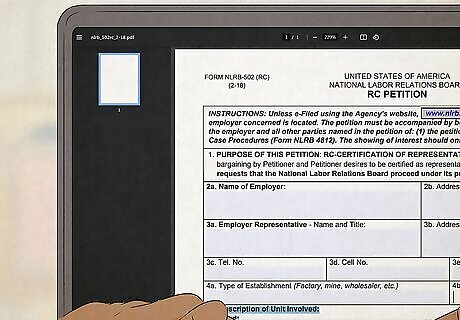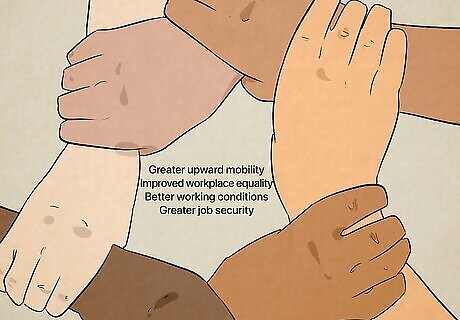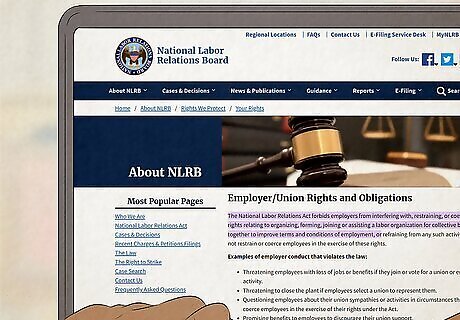
views
Starting a Union through an NLRB Election or Voluntary Recognition

Talk to your co-workers to see if they want to organize a union. Your employer can’t stop you from talking about unionization or encouraging employees to join during non-work time. By talking to your co-workers after work or during break times, you can see whether they want to improve their working conditions and if they would be willing to help you create a union. You can also find out what changes your co-workers would like to see and share your ideas about how unionization can affect those changes. Place union literature in non-work areas, like parking lots or break rooms. If your job is remote, email union pamphlets from your personal account to your other co-workers.

Contact a union organizer to form a union at your workplace. There may already be a union you can join that represents your industry and can guide you through the process of organizing a union at your workplace. Contact the union organizer at a pre-existing union in your area to start the process. The union organizer will provide you with union authorization cards (“A” cards) to distribute to co-workers. These cards are confirmation that each co-worker would like to form a union. Many U.S. labor organizations are organized under the American Federation of Labor and Congress of Industrial Organizations (AFL-CIO). You can also find independent unions in your state with the Unionbase tool or the U.S. Department of Labor’s search page.

Alternatively, create a petition to start a union at your workplace. To start your own union without the help of a union organizer, create a petition for co-workers to sign. This document will be used as proof that a certain number or percentage of your co-workers would like to form a union in your workplace.

Form a committee of co-workers who want to organize a union. Whether you are working with a pre-existing union or starting your own, assemble a committee of people at your workplace who want a union. Committee members research the benefits of unionization and educate and persuade their co-workers to support the union. When you organize, create an issues program that includes the improvements the committee hopes to achieve, like higher wages, better benefits, and/or improved working conditions. You can also warn co-workers about potential anti-union campaigns that your managers or employers might carry out. When convincing your other co-workers to unionize, highlight the benefits and wages that people in your industry receive when they’re unionized versus when they aren’t.

Ask your co-workers to sign a petition or “A” card. If you’re working with a pre-existing union, distribute the union authorization cards (“A” cards) provided to you to all of your co-workers. If you’re starting a union from scratch, create a petition and pass it around to your co-workers to sign. Circulate petitions and authorization cards during non-work hours to prevent your employer from penalizing you. Get signatures from your co-workers who are not supervisors or managers, since supervisors and managers are not usually eligible for union membership.

File a petition and hold an election if 30% of your co-workers sign. File a completed election petition and submit it along with all of your filled-out union authorization cards to your local NLRB office. An NLRB agent will make sure that an election in your workplace is appropriate and set up a secret ballot election. You might also be required to fill out and file this Certificate of Service stating that you gave notice of the petition to your employer. Elections may be in-person, by mail, or a combination of both.

Ask your employer to recognize the union if 50+% of your co-workers sign. If 50% +1 (or just over ½ of) co-workers vote “YES” to create a union, your employer is legally required to bargain in good faith over your working conditions. Work with your committee to negotiate a union contract between your employer and the union. If your employer has agreed to recognize the union, notify your local NLRB Regional Office that voluntary recognition has been granted. Negotiations usually take several rounds of bargaining. When the union and their employer reach a tentative agreement, the union holds a meeting and a secret ballot vote. If both sides agree to the contract, then it’s passed. If they reject it, both teams return to the bargaining table until they reach a new tentative agreement. If your employer refuses to recognize the union, file a petition for an election with the NLRB or mobilize the employees to go on strike. If 50% or more of your co-workers vote “NO,” then a union will not be formed in your workplace.
Pros and Cons of Starting a Union

Unions can lead to higher wages, better benefits, and job security. Union workers typically earn higher wages than nonunion workers. Unions can also arrange for affordable healthcare options, more paid vacations, holidays, sick days, and retirement and pension benefits. Unions can also lead to: Greater upward mobility: Higher wages, guaranteed health care, paid leave, and retirement can help workers improve their quality of life. Improved workplace equality: Unions adopt anti-discrimination measures and promote practices that close race and gender wage gaps. Better working conditions: Unions negotiate for stronger laws to protect workers. They also require safety equipment and encourage workers to report unsafe conditions without fearing retaliation. Greater job security: Union workers can only be fired for poor job performance or “just cause,” while nonunion workers can be fired for any reason except based on race, religion, or age.

However, unions charge dues and might misuse these funds. One of the biggest drawbacks is that unions charge dues which are typically used to pay the salaries of union workers in case of a strike. Typically, these dues are 1 to 2% (roughly 2 hours) of your monthly wage. Some unjust unions spend these dues on six-figure salaries for union leaders or luxurious offices. Slower advancement: Many unions have rules that favor workers based on seniority. This means that newer employees may be more likely to be passed over for promotion. Employers also may not be able to reward exceptional employee performance because of labor contracts. Less autonomy: Union workers are bound to obey any decisions made by the union. Workplace tensions: Unions can create tension between workers and employers, potentially causing workers to have lower levels of trust and satisfaction in the workplace. Unpaid strikes for nurses: Unlike other careers, nurses who belong to a union aren’t paid during a workers’ strike.
Knowing Your Rights as a Union Organizer, Member, or Nonmember

You have the right to form, join, or assist with creating a union. This includes distributing pamphlets, wearing union buttons or t-shirts, asking your co-workers to sign petitions or authorization cards, and discussing the union with your co-workers. If your rights or the rights of others have been violated, contact the NLRB within six months to report it. You also have the right to: Negotiate with your employer over your terms and conditions of employment. Address work-related issues and share information about pay, benefits, and working conditions with co-workers on Facebook, YouTube, and other social media. Strike, picket, and protest peacefully about work-related issues.

You can't be fired, disciplined, or demoted for engaging in union activities. Your supervisors and managers are also not allowed to spy on you, question you, threaten you, or bribe you regarding your union activity or the union activities of your co-workers. However, your employer can prohibit you from doing union work during work hours. You can lose this protection by saying offensive or knowingly false things about them, or by publicly insulting their products or services without relating your complaints to any labor issues.

You also have the right to decline to participate in a union. No employee in the U.S. can be legally required to become a full dues-paying union member. If you’re part of a union, you have the right to resign from membership at any time. Unions are also legally required to treat nonmember employees the same as members. In some states, it’s legal for a private-sector employee to be forced to pay union dues or be fired from their job. Those living in Right to Work states are protected from this. If you don’t live in a Right to Work state but have religious objections to supporting a union, you have the right to ask the union to send your dues amount to charity. You also have the right to campaign against a union. Contact the National Right to Work Foundation if you’d like to petition to oust a union in your workplace.


















Comments
0 comment